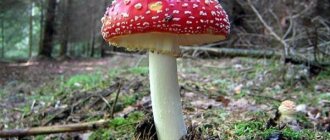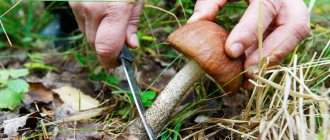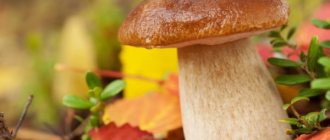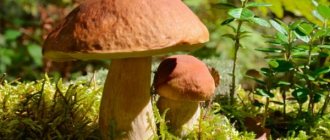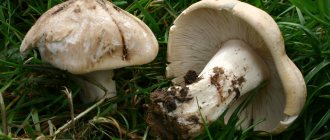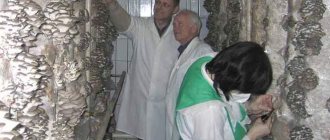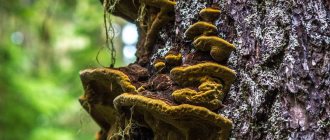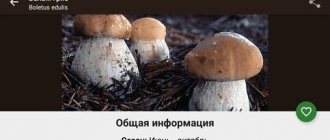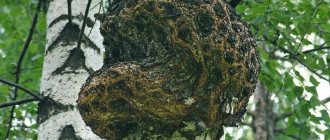The Moscow region is a mushroom region, because during the season here you can collect not only chanterelles, russula or honey mushrooms, but also more valuable boletus mushrooms, because the porcini mushroom is considered the most successful find for a lover of “quiet hunting”. Naturally, in order to reap a rich harvest, you need to know the places where boletus mushrooms are most often found. Experienced mushroom pickers do not spend much time searching, because they only go to certain places.
If you also want to please your family with tasty and healthy boletus mushrooms, as well as pickle or dry them for the winter, we recommend that you read the material in this article, where you will find all the necessary information for a successful “quiet hunt” in the Moscow region.
Porcini mushrooms in the Moscow region
The climate and natural conditions of the Moscow region make it possible to collect mushrooms almost all year round, because the first fruiting bodies begin to appear in the spring. Of course, the peak harvest occurs in late summer and early autumn, but this completely depends on weather conditions.
For example, if the summer was cool, all the main species will appear almost simultaneously, and not in turn, as is usually the case. However, to harvest a bountiful harvest, it is better to go to the forest in the fall, when weather conditions stabilize and become optimal for the development of fruiting bodies.
It is noteworthy that in the Moscow region there are many edible species. Among them there are chanterelles, honey mushrooms, and boletus. No less common are lamellar varieties, such as russula, but the most valuable find for any mushroom picker will be boletus, because the pulp of its thick stem and fleshy cap really contains a lot of useful substances.
Benefits and harms
Nature gives man its riches, which include not only oil or gold. The gifts of the forest delight with their diversity, beauty and benefits. Mushrooms naturally contain a huge amount of vitamins, fiber, protein and various microelements.
Benefit
Mushrooms are low in calories. During a diet, they easily replace regular meat and serve as an excellent addition to the daily diet.
Scientists have discovered 18 amino acids in their pulp. This is a very large number, because... There are only 20 protein-forming amino acids.
Scientists have proven the effectiveness of anti-cancer therapy based on the use of extracts and extracts from the fruiting bodies of various forest mushrooms, which is due to the action of the substance beta-glucan, which is part of the mushrooms.
Harm
Mushrooms are difficult to digest. Chitin, which is part of the cell walls of the fruiting body, slows down the digestion process. If cooked incorrectly, food fibers rot in the stomach.
Irina Selyutina (Biologist):
Despite the obvious benefits of mushrooms, they still have a number of contraindications.
- Edible mushrooms can cause serious illness or severe poisoning. Poisoning can be caused by an old, wormy or stale mushroom. Therefore, it is better to buy them in stores or from time-tested sellers on the market.
- Excessive enthusiasm for eating mushrooms can provoke the development or exacerbation of gastrointestinal diseases. Experts attribute this to the presence of chitin in the composition, which is not subject to our digestive system and is practically not digested. Its regular excess can lead to various problems, in particular gastritis.
- There are also age restrictions for children, which is due to the incomplete development of the glands of their digestive system.
- The physiological state of an adult is also the basis for the occurrence of health problems when consuming mushrooms:
- pregnancy and lactation;
- elderly age.
Mushrooms absorb toxins from the environment with their entire surface. Therefore, it is better not to collect mushrooms near busy highways, industrial enterprises or landfills. Otherwise, the risk of getting a lot of toxic compounds from exhaust gases or decomposition products from these very unpleasant places into your body increases.
Use in cooking
Lovers of delicious dishes will not be able to refuse the pleasure of trying forest delicacies.
Camelinas, boletuses, boletuses, honey mushrooms, etc. make wonderful dishes, with a unique delicate taste, with a variety of aromas that will not leave anyone indifferent. Mushroom soup is very popular in the world, and each country has its own special notes.
Pickles and salads acquire a special charm. And frozen and dried delicacies will allow you to enjoy them long after harvest.
Where porcini mushrooms grow in the Moscow region
There are quite a lot of forests rich in mushrooms around the capital, and you can get to them not only by personal, but also by public transport (bus or train). However, the peculiarity of the region is that in certain areas, as a rule, individual species are found. Therefore, if your task is to collect more boletus mushrooms, the area for “quiet hunting” must be chosen carefully. So that every mushroom lover can choose a place for collecting, we will present the most popular and productive mushroom places in the Moscow region (Figure 2).
These include:
- Ruza district: considered an ecologically clean area, which is ideal for “quiet hunting”. The areas near Oreshek and Novovolkovo are considered especially fruitful, but it should be borne in mind that in this area the majority of honey mushrooms are found, although some manage to find a small harvest of white ones.
- Stupinsky district: there are several truly productive places here, which can be reached by train from Paveletsky station. For example, white ones can be found a few kilometers from Shugarovo and Zhilevo stations. But, in addition to boletus, in local forests there are quite a lot of russula, boletus and other edible species.
- Yegoryevsky district: this area is very rich in mushrooms. In the forests near the villages of Shuvoe, Savvino, Kostino, Vereika and Bolshoye Gridino, not only boletus mushrooms are found, but also boletus, boletus and chanterelle. However, it should be taken into account that you must go to this area with a map, since there are many old paths and paths in the forests in which it is easy to get lost.
Figure 2. Map of the best places for “quiet hunting” in the Moscow region.
Odintsovo district is considered an equally popular mushroom place. Large families of honey mushrooms and boletus mushrooms are found here. The Dmitrovsky district also offers real abundance, because here you can find many valuable edible species: boletus, chanterelles, boletus, saffron milk caps, boletus and boletus. In general, experienced mushroom pickers note that the Moscow region is such a fruitful region in terms of mushrooms that you can go on a “quiet hunt” in almost any direction. Your trip to the forest will not be in vain and you will definitely pick up a basket full of tasty and healthy forest mushrooms.
Mushroom picker calendar for 2021
The table shows the most suitable times for collecting edible mushrooms. The information is relevant for the Moscow region:
| Name of mushrooms | April | May | June | July | August | September | October |
| White | + | + | + | + | + | ||
| Morel | + | + | + | ||||
| Mosswort | + | + | + | + | + | ||
| Oyster mushroom | + | ||||||
| boletus | + | + | + | + | + | ||
| Boletus | + | + | + | + | + | ||
| Honey fungus | + | + | + | + | |||
| Oiler | + | + | + | + | + | ||
| Raincoat | + | + | + | + | + | + | |
| Champignon | + | + | + | + | |||
| Umbrella | + | + | + | ||||
| Gruzd | + | + | |||||
| Hedgehog | + | + | |||||
| Chanterelle | + | + | + | ||||
| Ryzhik | + | + | + | ||||
| Volnushka | + | + | + | ||||
| Ryadovka | + | ||||||
| Russula | + | + | + | + | + |
When to collect porcini mushrooms in the Moscow region
Everyone knows that fruiting bodies develop best in warm and humid weather. It follows from this that you need to go on a “quiet hunt” after heavy rains have passed, but the air temperature is quite high.
As a rule, in the Moscow region, the first porcini mushrooms appear in July, although August and early September are considered the traditional harvest time. However, it should be borne in mind that much depends on the climatic conditions of the year. For example, if the summer was rainy and not too hot, a large number of boletus mushrooms will appear in mid-summer, and in a warm and moderately rainy autumn they can be collected until the beginning of October.
Note: These features apply exclusively to boletus mushrooms, which require special weather conditions for development. However, if you are an experienced mushroom picker, you can harvest at almost any time of the year.
For example, in the spring the first morels appear, which, although they have a very unusual appearance, are excellent for eating. In addition, if you know the places, you can find mushrooms even in winter, because at this time of year you can find winter mushrooms on old stumps or fallen tree trunks, which can be used for frying or pickling.
However, if you do not have enough experience, it is better to go into the forest with a more experienced colleague, be sure to take a map with you and put in the basket only those specimens that you are absolutely sure are edible.
Vegetation of the area
The Moscow region is rich in forests, which are home to almost all mushrooms. Forests cover slightly less than half of the region's territory. These are mainly mixed forests. They are most typical for the central and western parts of the region. In the east, coniferous forests of spruce, spruce with pine and pine are not uncommon. There are also forests with a large proportion of small-leaved (sometimes broad-leaved) species with pronounced undergrowth and dense grass cover. The forest vegetation of the northern part of the Moscow region is more consistent with the southern taiga zone.
In the southern part of the region there are broad-leaved forests and agricultural lands.
The species composition of the forest affects the growth characteristics and species composition of mushrooms.
Rules for collecting porcini mushrooms in the Moscow region
The basic rule of any mushroom picker is: “You can only collect those mushrooms that you are absolutely sure are edible.” If you have even the slightest doubt about the edibility of a specimen, it is better to immediately consult a more experienced mushroom picker, or simply ignore the suspicious specimen (Figure 3).
However, when going for mushrooms in the Moscow region, you should follow some other rules:
- It's better not to go into the forest alone. This puts you at risk of getting lost or going astray. When going for mushrooms, be sure to warn your family or friends about the location of your walk and the expected duration of your stay in the forest.
- Be sure to take safety measures: charge your phone, take matches, a small supply of water and food with you. Even if you accidentally get lost in the forest, you will have the opportunity to replenish your strength.
- Choose the right clothes for your walk. It is better not to wear camouflage or dark clothing in the forest. Give preference to bright things, preferably with reflective elements.
- You should only enter the forest during daylight hours to make it easier to remember the signs of the area.
Figure 3. Rules for collecting boletus mushrooms
In addition, you must wear rubber boots, long sleeves and a hat. This will keep you away from snakes, ticks and mosquitoes. And remember that when collecting any mushrooms, including porcini, you need to carefully inspect each specimen so as not to accidentally put a poisonous double in the basket.
You will find more interesting and practical information about “silent hunting” in the Moscow region in the video.
May
Probably every mushroom picker dreams of going home with bags full and buckets of saffron milk mushrooms, porcini mushrooms, and real milk mushrooms, but such trophies are not yet collected in May. The early harvest is mainly represented by:
- Morels growing in deciduous forests, on rich fertile soil, in willows. Growing both in groups and singly, they are also found in mixed forests.
- In the deciduous forest you can find a lot of String-caps, which are considered a type of the above-described trophy, which is classified as a conditionally edible mushroom.
- In the meadow and clearings you can find puffballs that actively bear fruit immediately after the Morels and their “brothers” Stochki.
- The spring mushroom in this region, Oyster mushroom, can be found on brushwood. But it is better not to collect such trophies from decaying fallen trees.
September
September is the period when mushroom pickers continue to hunt for summer trophies, while at the same time collecting honey mushrooms and pigs. At this time, other autumn mushrooms also bear more fruit, including the mushrooms.
What you need for mushroom “hunting”
An important aspect of a successful “hunt” is the equipment of a mushroom picker. What should it include:
- comfortable clothes and shoes;
- plastic bucket;
- mushroom knife;
- a stick to push apart the grass in search of mushrooms;
- first aid kit;
- drinking water;
- snack sandwiches;
- navigator;
- phone with full charge.
June
In June, a lot of things are collected in the Moscow region:
- They are oiled with a pleasant aroma, as well as a constant beautiful color on the cut.
- Much-loved chanterelles, which are extremely important not to be confused with their dangerous counterparts. Experienced mushroom pickers know that the chanterelle will turn red where you press on it; you can distinguish it from a harmful trophy by the characteristic shape of the edges of the cap.
- Champignons, which are extremely valuable in cooking because of their taste and the pleasant aniseed smell of the pulp.
- Visually similar to the Polish Green Flywheel mushroom, which can often have an olive or even brown cap.
